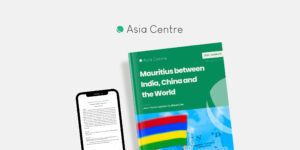For those Europeans concerned with EU-China relations, having a look at recent trends in China’s dealings with India may be unexpectedly illuminating. Europeans have tended to believe that their own shortcomings are the sole origin of difficulties faced in the relationship with China; the Asian superpower has after all proven to be a reliable – if somewhat demanding – partner.
Five years ago, many Europeans looking at China and India were ready to believe the hype about ‘Chindia’ – a term famously coined by Goldman Sachs – or even the “two pagodas of hardware and software”, as PM Wen Jiabao marvellously called the cooperation between the two countries in April 2005. It seemed that two emerging giants were creating a new world, and Wen’s choice of words carried an air of cultural inevitability: if the PRC premier had gone so far as to acknowledge, albeit indirectly, the historical relationship between Hinduism and Buddhism, it could only be the sign of a deep rapprochement between the neighbouring states. Surely, then, a new Asian trade- and power- bloc would shortly be formed?
Events have proven otherwise. China’s contest of India’s ownership of the North-Eastern state of Arunachal Pradesh – where a major Tibetan temple is located near the existing border with China – its readiness to take on India over the issue of India’s control of Kashmir, its plans to create massive hydrographical projects on the upper reaches of the Hindus and Brahmaputra as well as its protests against the refuge given to the Dalai-Lama are all souring relations. There has been, however, enormous progress in bilateral trade, and a symbolic reopening of trans-Himalayan border passes. New Delhi’s business establishment meanwhile has begun a capital-investment love affair with the comparatively freewheeling Chinese market. Yet Delhi is smarting over the lack of Chinese support for a permanent UN seat for India, and has clammed up on many issues. It is, for example, restricting Chinese investment in sensitive sectors, and is competing with China for greater influence in Burma.
Should this be a lesson for Europe? Yes – in a fundamental sense. China feels it is ascending, and it will at some point pursue an aggressive line with any former partner, large or small, that poses a challenge to its self-image. This was the case with Japan for almost a decade, from 1998 to 2006; it is now the case with India. Furthermore, major international disputes are not always what they seem. In a recent editorial, the China People’s Daily robustly denounced India’s choice to “befriend the far and attack the near”; or, in other words, to rely on the United States and oppose the interests of China and Pakistan. Such broad criticism suggests we are far from the concrete resolution of the border spats of previous years.
The Chinese-authored analyses that Yann Dompierre, Mathieu Duchâtel and Thibaud Voïta have uncovered are complex. The Chinese experts cited below do not, on the whole, engage in unmitigated polemics. They acknowledge past quarrels in dispassionate terms whilst searching for means of strengthening the relationship. They note accurately that trade relations alone will not suffice for this purpose. They show remarkable cool over the IndiaU.S. strategic partnership, noting all the elements that may one day reduce its potency; yet they fail to mention what is Beijing’s greatest headache – India’s nuclear pact with the United States. Chinese experts don’t emphasize their own country’s weakness, just as they almost never mention antimissile defence systems in North-east Asia. They advocate finding a patient way of achieving this goal. Just as there have been moments calling for tough talk and confrontation, the present situation demands a peaceful strategy. They talk about a “change of concept” – but then prescribe it for New Delhi, not for Beijing. In doing so they create a more nuanced language for the issue, one which is clearly very far from the emotional phrasemaking of Chinese press op-eds and bloggers.
None of these sources mentions that China and India have managed to work together as allies twice in the last year: once to derail the Doha round of WTO trade talks by denouncing demands for free trade made by more industrialised nations; and, very recently, with a joint memorandum on climate change which looks like an effort to resist any coercion by the West ahead of this year’s Copenhagen Conference.
Each of these collaborative adventures looks like a pragmatic alliance formed to defend immediate economic interests. They show that China and India are consummate practitioners of international institutions – and realists above all. To persuade them in the future, Europe and other powers will have to learn to speak the language of their pressing needs and interests. China and India may not be about to form “a new Asian power bloc”, but neither are they supporters of the post-war liberal order.
Summary
– CHINA AND INDIA: RIVALS ALWAYS, PARTNERS SOMETIMES –
A fraught political relationship (Yann Dompierre)
Despite strong growth, trade remains modest (Thibaud Voïta)
US and India: a partnership at China’s expense (Mathieu Duchâtel)
Betting on Pakistan (Mathieu Duchâtel)




